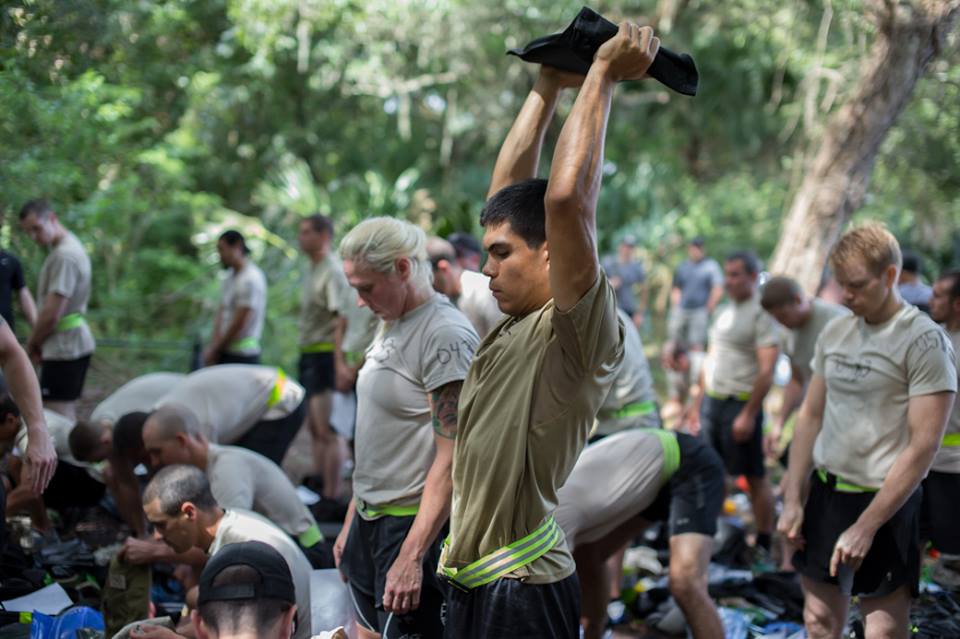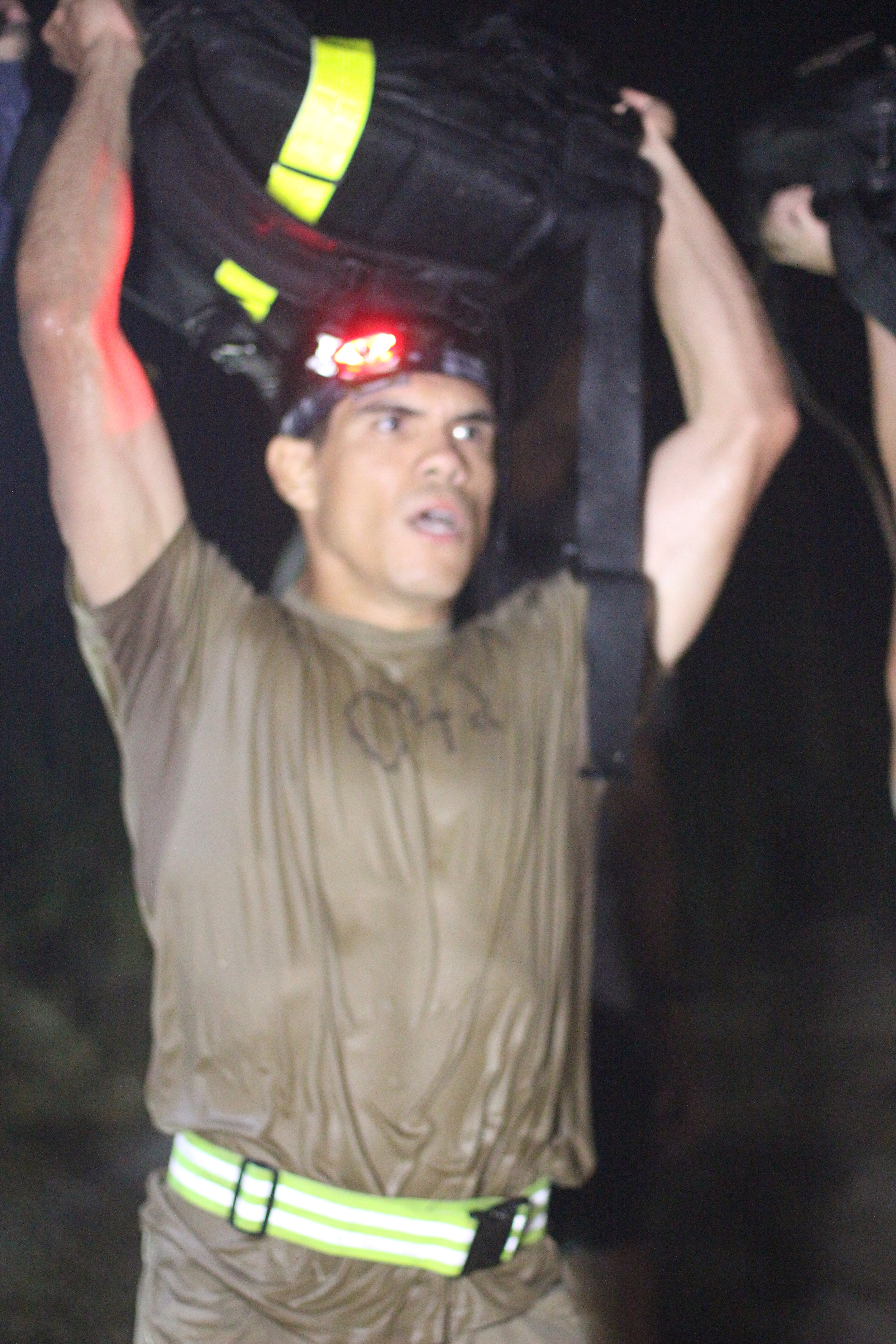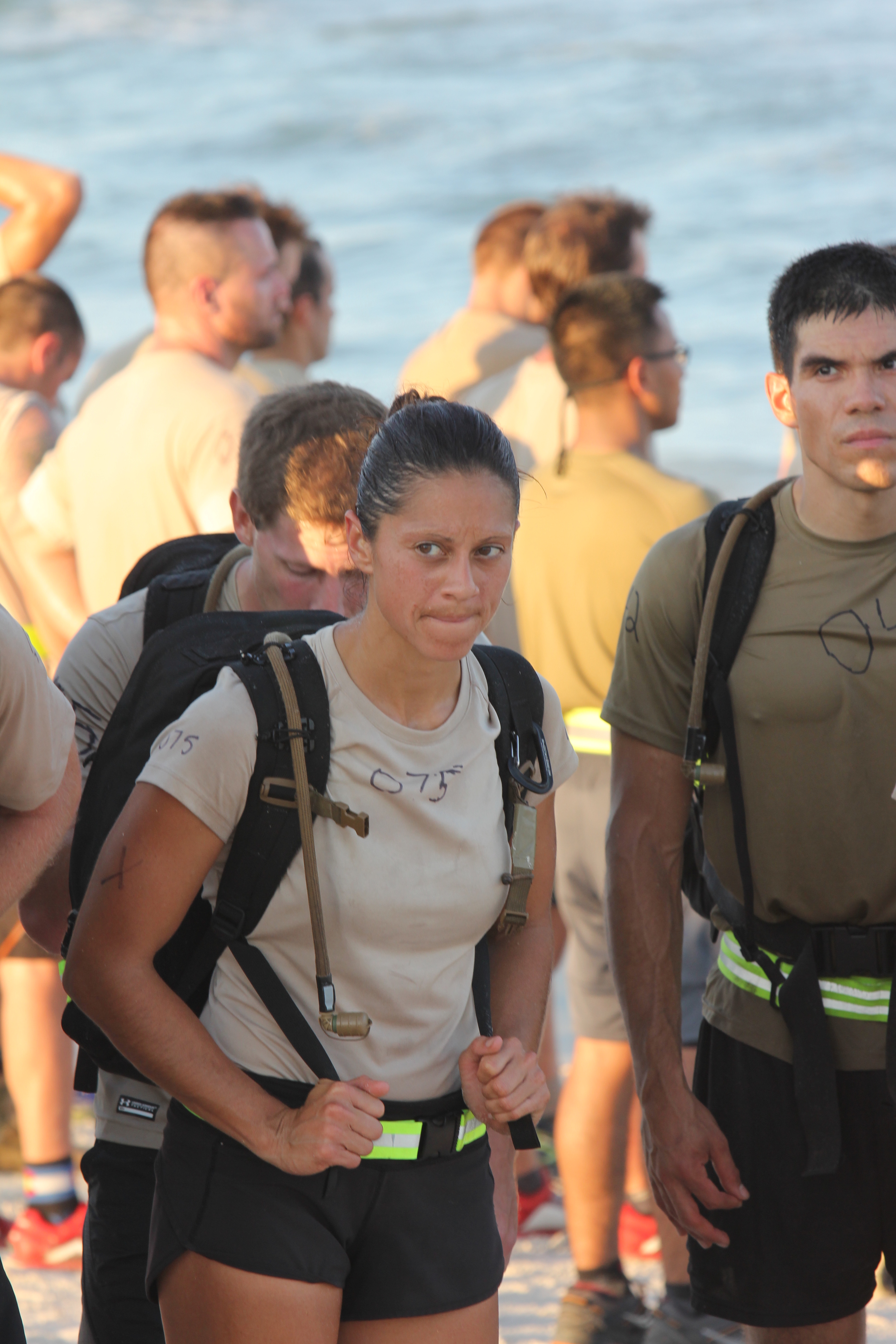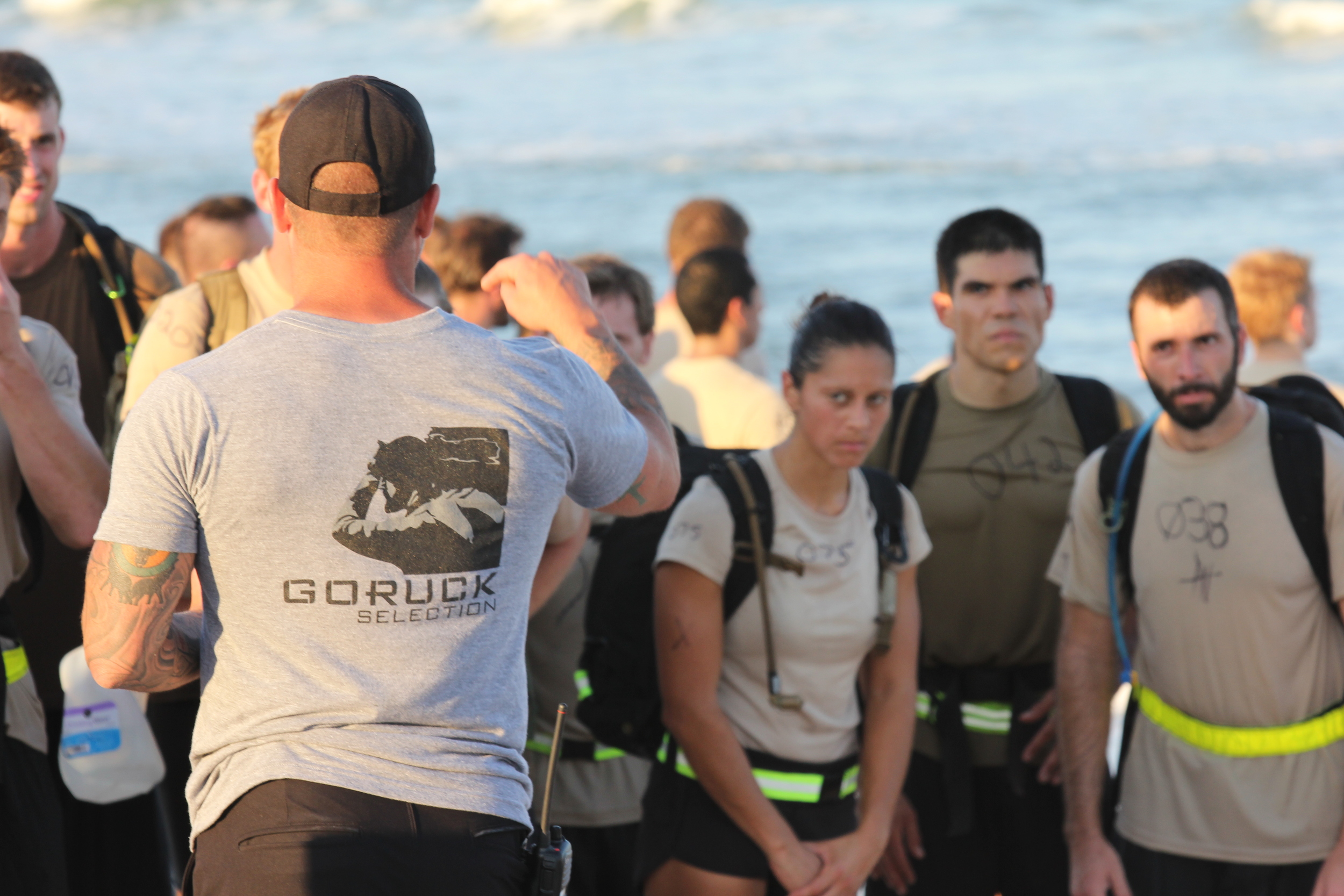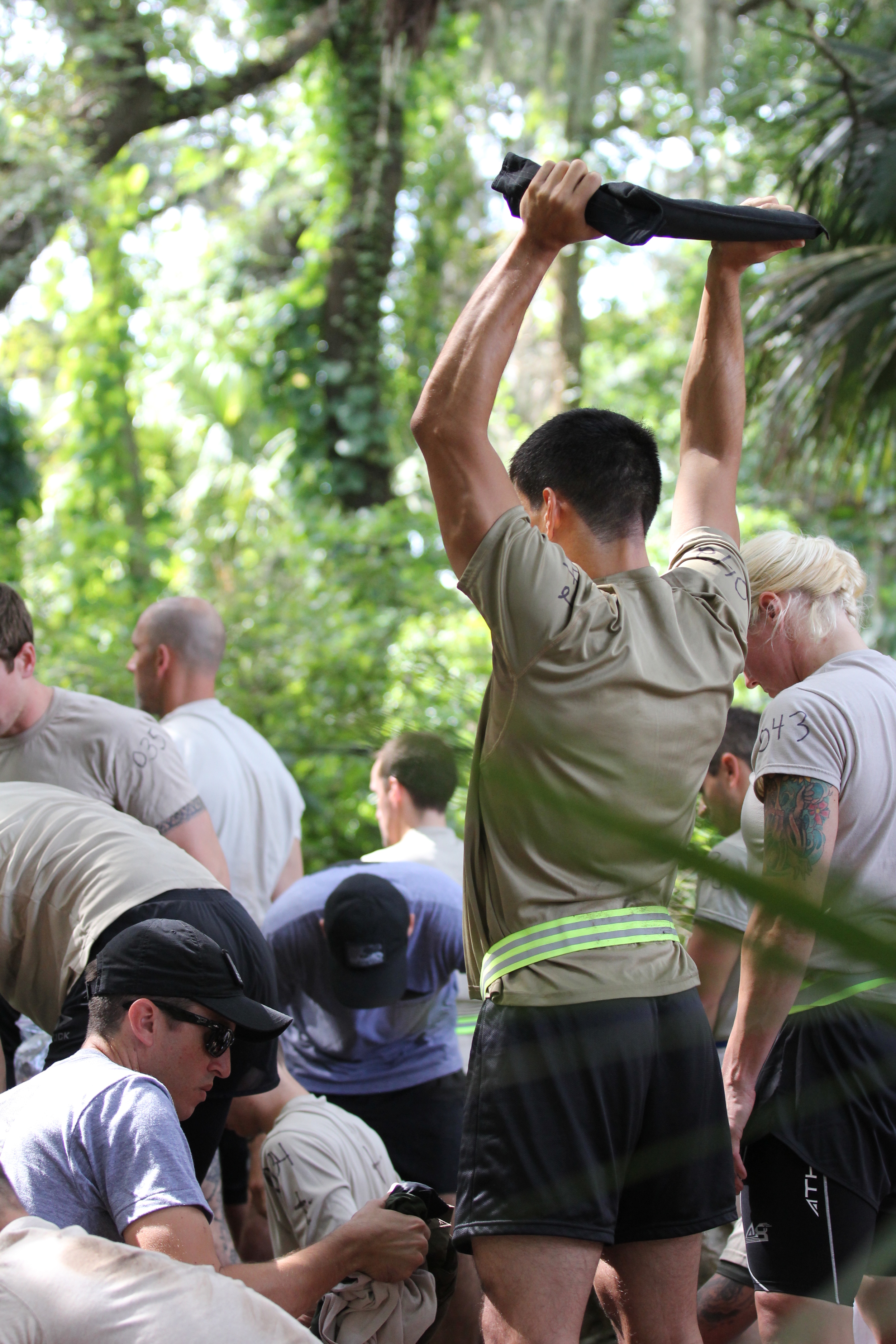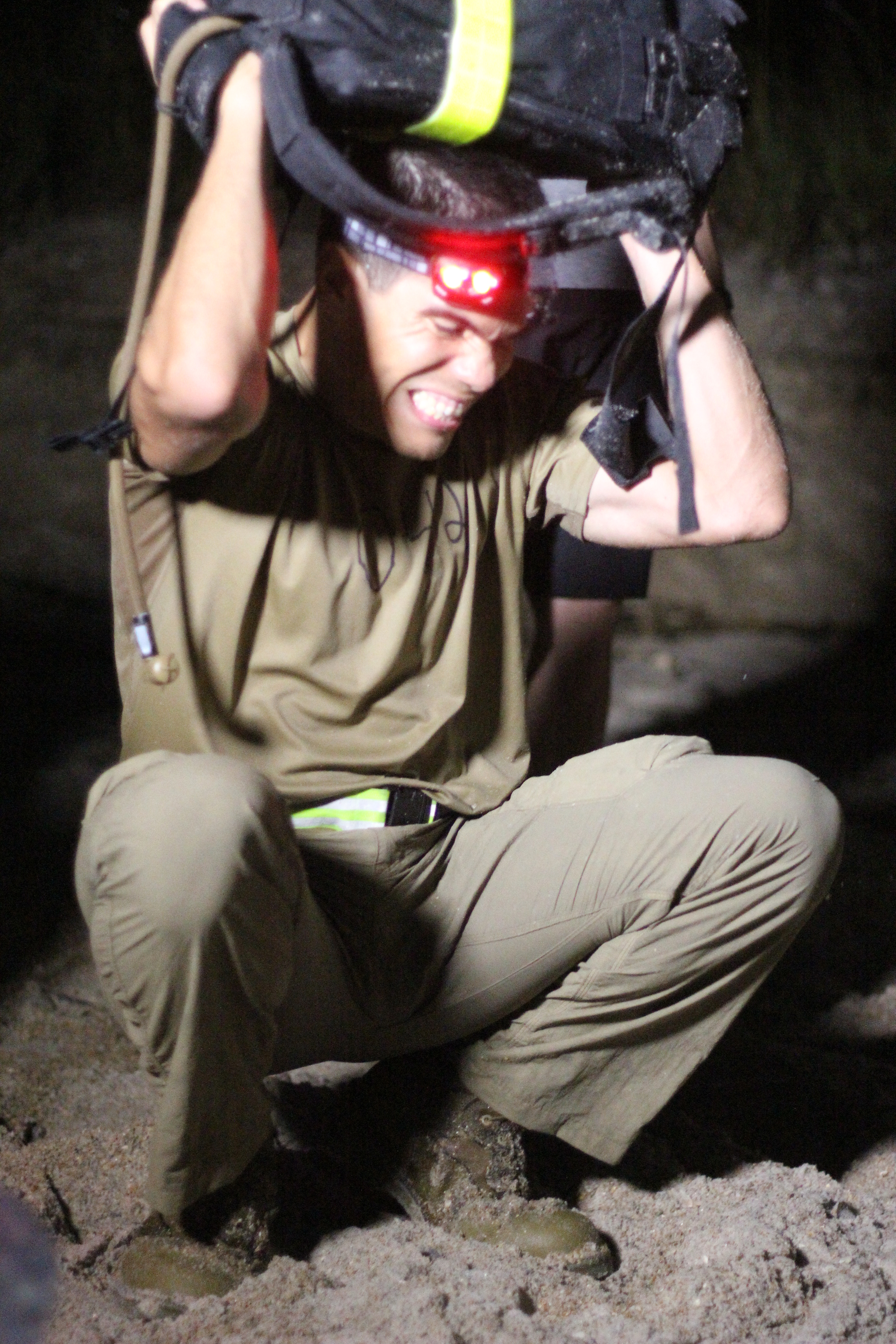TR: I saw you throughout the fitness test and then through most of the Welcome party. You were doing great. I had heard before Selection that you never really see how people exit, you just look around and they are gone. I looked around for familiar faces and they were all gone. What happened to you?
JH: There were three issues during the Welcome Party that broke my resolve. The first was my gear set-up. I went with GORUCK's recommendation to use a GR0 for Selection, but the boots I planned to use did not fit in the rucksack with a full hydration bladder and other items. I concocted a set-up where I attached a GORUCK brick bag to the GR0 with carabiners so that I could store my boots (and later shoes). This was a terrible idea in retrospect because it made the rucksack heavier and certain exercises more difficult than they needed to be. Also, the reflective belt I used on my rucksack kept coming off (tip: don't use velcro belts), and that warranted special attention from the cadre.
The second was a weakness that came up during Selection, overhead squats. I did not have the flexibility to do these properly, and this affected how I perceived my performance during the Welcome Party.
The third were the warnings of being performance dropped after finishing last in a couple of Welcome Party events. At that point, I was tired, my legs were feeling heavy, and I felt I couldn't perform to standard. I was already fighting doubts on whether I trained hard enough for Selection, but I was able to keep those doubts at bay as I progressed through the PT test. The warnings, however, psyched me out.
Those three issues created a perfect storm where I doubted my ability to continue and convinced myself that I was better off quitting, address my weaknesses, and come back stronger for the next event. Was that really the case? It's debatable. I probably could have stuck it out longer, but my gear and flexibility issues would have made that very difficult.
TR: What lessons did you learn from Selection?
JH: Test my gear thoroughly. Due to time constraints, I didn't have an opportunity to fully test my final Selection load-out before the event. If I did, I wouldn't have gone with the brick bag set-up. I might have used a GR1 over a GR0.
I also learned that I needed to work on my flexibility. I saw a personal trainer after Selection and he pointed out areas where I was really tight. He recommended a variety of exercises to loosen up, so I now incorporate those into my workouts. I'll also be working on my overhead squat.
TR: Looking back at Goruck Selection in Jacksonville. Do you consider it a success or a failure in your eyes? Explain why…
JH: While not finishing Selection was a disappointment, I still consider it a success because I got to see what my weaknesses are. I have a clear idea on what I need to do to address them, and I'm excited at the thought of getting even stronger. I've learned that failure isn't necessarily a bad thing if you approach it as a learning experience and use it as an impetus to make yourself better.
TR: Are you going to try Selection again? What will you do differently?
JH: Yes, I have registered for Selection 017 at Bozeman, MT in August 2015. Jon Eytchison, the sole finisher of Selection 015, described his Selection training plan in his AAR. That will be the blueprint for my Selection training plan. I’m also doing a Pre-Selection prior to Bozeman to gauge whether I'll be ready for the actual event. What I learn from Pre-Selection will guide the final months of my Selection training.
TR: What pack do you expect to use in Bozeman Selection? Which did you use in Jacksonville Selection? How do you think you will prepare your gear differently for Bozeman Goruck Selection considering what you have learned from the Jacksonville Goruck Selection?
JH: I used a GR0 for Jacksonville, but I couldn't fit my boots in the ruck with a full hydration bladder. One thing that was interesting was that Jon had the same problem fitting boots into his GR0, so he didn't bring any to Selection! I'll either have to find lighter boots (which are hard since ultra wide boots that drain are not common) or consider using a GR1 instead. I'll also pack as few items as possible. Since the cadre are going to dump all our gear out at the beginning of the event, having fewer items will make stuffing them back into my ruck a lot easier and less stressful.
TR: One of the things that we have discussed extensively is the possibility of doing SealFit Kokoro. Is this something that you are going to do?
JH: Yes, I'm registered for Kokoro 36 in February.
TR: How are you preparing for Kokoro?
JH: I'm doing a mix of Wendler's 5/3/1 Lifting (for strength), Military Athlete's Murph plan (to prepare for Kokoro's Murph requirement), the running portion of the BUDS Warning Order for Navy Seal Training, and long runs on Saturday. I have also been taking cold showers to prepare for the Pacific Ocean surf torture.
TR: Did you have any foot issues in Goruck Selection? What are you doing to prepare your feet for Kokoro and Selection now?
JH: No. Despite my ankle injury from HCL, it didn't come up at all during Selection. I didn't get any blisters during Selection, and I attribute that to my set-up of Trail Toes, Injiji toe socks (as a liner), and Merino Wool boot socks. I've rucked as far as 20 miles in this set-up without issues, so I imagine that it will serve me well during Kokoro. As for preparing my feet for Kokoro and Selection, I train in wet boots when I can.
TR: Do you have any expectations or goals for Kokoro?
JH: A key point that keeps being brought up in Kokoro videos and AARs is to know your why, as in why are you doing this? There are various reasons why I’m doing Kokoro (such as becoming a better leader), but my main reason for going through a crucible like Kokoro is to give me insight on what's needed to pass Selection.
TR: I think that the best meal I have ever had were those 3 burgers, fries and 2 milkshakes that I had with you the day after Goruck Selection! I know you are probably watching your diet now and dreaming of food. Do you have a meal that you plan on eating after Selection Bozeman, SealFit Kokoro?
JH: It will either be a burger, fries, and shake combo, or a whole pizza pie.
TR: When I have the opportunity to talk to someone who is into the same things I am (Selection, Kokoro, heavy training) I always want to know one thing…why are you doing this?
JH: Jason McCarthy, the founder of GORUCK, had said this and it has stuck with me ever since, "Live life to the fullest, because tomorrow is not a promise." Since there is no guarantee that I’ll be around tomorrow, I have to treat each day as a gift and make the most of it. Training for these events and testing my limits is my way of fulfilling that credo. Also, I enjoy a good challenge, and I get pleasure out of completing something that people consider hard or impossible.
TR: Imagine that it is 3:45 am, you are submerged in the cold Pacific Ocean and you are as cold as you have ever been. The instructors demand that you continue this beach party for another 4 hours. What are you going to think about to get you through?
JH: I'll have to rely on my mental toughness techniques to get through that. As bad as the surf torture will be, it will end at some point. Others before me have gone through a similar experience, and if they can complete it, so can I.
TR: The thing I struggled with most was training for the lack of food and electrolytes. In Selection, we did not get anything to eat and only a few stops for plain water for 18 hours of intense exercise. I started cramping, throwing up and having issues related to electrolyte imbalance. 037, ended up in the hospital with very serious Rhabdo, and eventually Tubular Necrosis. Do you think that you can train your body to be ready for the lack of nutrition and electrolytes? If so, what are you doing?
JH: I talked to some Selection finishers regarding their diet plan prior to Selection and both recommended Intermittent Fasting, where you only consume calories during a specific period of the day. One also suggested Ketosis, where you restrict your carbohydrate intake to get your body fat-adapted. This was the diet I followed before Selection, and I wasn't feeling hungry during the Welcome Party. I don't know how my body would have reacted if I got past the Welcome Party, but I see myself following the same plan when I'm prepping for Selection again.
TR: From what you learned from Goruck Selection in Jacksonville, do you think that you could lay out some benchmarks that anyone would need to be able to complete easily to make sure that they made it through the Fitness Test and the Welcome Party?
JH: You need to do 80 push-ups, 100 sit-ups, run 5 miles in 35 minutes, and ruck 12 miles with 45# dry in under 3 hours. That will give you a fitness cushion that will ensure that you’ll complete the standards regardless of your state. I guarantee that you won’t be at 100% when you do the Selection PT test, most likely because of nerves.
Proper form is also vital. Cadre will no-rep any push-up or sit-up that is not up to standard, so make sure that when you’re hitting those benchmarks, that they are done properly. I strongly recommend asking GORUCK cadre to review your push-up and sit-up form. Mark Webb has an excellent write-up on push-ups that can also help.
I got this tip from Cadre Surfhog after Selection: do the hardest workout imaginable, then do the PT test. If you can pass the PT test in a fatigued state, you have an excellent chance of passing the Selection PT test.
As for the Welcome Party, it's a non-stop nightmare of ruck PT, so do something like Boot Camp or Crossfit with your ruck. View the last fifteen minutes of GORUCK Selection (see "1230 Saturday / Shark Attack" in the Selection 015 recap) and do those exercises. If you have issues with any of those exercises, then you know what you need to work on.
I would also recommend seeing a personal trainer and have him or her review your flexibility. If you are tight in certain areas, learn the corrective exercises from the trainer and incorporate them into your warm-ups and cool-downs.
TR: Jonathan, it is an honor to know you. You are a true inspiration and a great example of someone living his life to its full potential. I wish you all the best and I know that you will be successful in your quest for Selection and Kokoro. Can we catch up and do another interview after Kokoro?
JH: Thanks! I appreciate the advice you've given me as I prepare for Kokoro. I will absolutely do another interview after SealFit Kokoro.





















